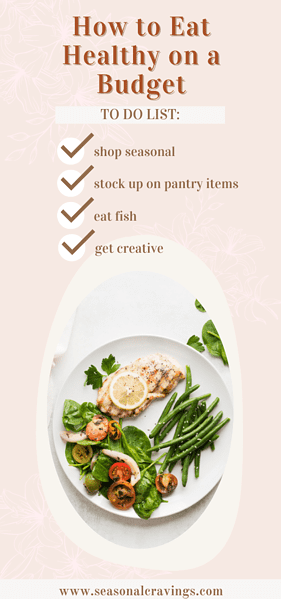Generally speaking, we don't think about eating healthy and budget-friendly as going hand in hand. But with a bit of creativity and careful planning, you can eat healthy while still being mindful of your wallet.
There are many diets, such as Keto, Whole30, or vegan, but eating healthy is not so much about trendy diets as it is about finding nutritious foods specific to your health conditions, body type, lifestyle, and, most importantly, your budget.
How Can I Lose Weight and Eat Healthy on a Budget?
I know that many people are concerned about how to eat healthy and lose weight on a budget. But everyone's body is different; what is healthy for one person might not be the same for another.
For example, green tea is touted to be one of the healthiest drinks that aid with weight loss, but some people like me, who are sensitive to caffeine and live with lower blood pressure, may not be able to fully enjoy the benefits of this beverage on a regular basis. This is the advice I got from all my doctors, so as you can see, it's important to understand your medical history to incorporate healthy foods into your lifestyle that will work best for you.
Once you consult your doctor, nutritionist, or dietitian to create a healthy diet plan that fits your needs, then it won't be hard to figure out how to keep the costs reasonable.
Whether you're a single mom, a college student, or someone who just wants to save money, here are some tips on how to eat healthy on a budget:
1. Shop around for seasonal fruits and vegetables.
Seasonal fruits and vegetables are always cheaper than their off-season counterparts.
Shopping for seasonal produce is a great way to fill your grocery basket. For example, strawberries are cheaper in the summer, while apples are usually cheaper in the fall and winter months when they're in season.
During the fall time, make pumpkin soup, or bake sweet potatoes to take advantage of some of the seasonal produce.
PRO TIP: Frozen fruits and vegetables are a great option if fresh produce isn't available. Frozen may be cheaper, but they are just as nutritious, plus they last longer since they are already pre-cut and frozen.
2. Stock up on non-perishables when they go on sale.
A tried-and-true strategy to cut your grocery bill is by shopping smarter and planning ahead. Stock up on non-perishables such as dried beans, whole grain pasta, oats, and quinoa when they are on sale, so you'll always have something nutritious in your pantry.
Other non-perishables with long shelf lives include canned salmon, nut butter, and raw nuts and seeds.
PRO TIP: Beans and whole grain foods are fiber content higher than other starchy carbs like white bread and rice, so they are healthier and help fill you up for longer.
3. Load up on legumes.
What's another type of non-perishable food you can stock up on?
Legumes are perfect foods if you want to make a quick and nourishing meal for your family.
Many legumes like beans, peas, and lentils are very affordable, high in fiber and protein, and extremely versatile. For example, you can make burgers out of lentils or use black beans to make a delicious burrito bowl.
According to NCBI, legumes provide many health benefits - they are naturally low in fat, practically free of saturated fat, and because they are plant foods, they are cholesterol free as well.
So, the next time you want to replace your white rice or high-carb starchy pasta, opt for legumes like black beans, chickpeas, or lentils instead for a healthier alternative.
FUN FACT: Did you know that peanuts are legumes, not nuts? They are a great source of fiber and monounsaturated fat, the healthy fat found in olive oil.
4. Include fish once to twice a week within a budget.
Healthline says eating fish at least once or twice a week is important for your heart and brain health.
Many of us think that fish can be expensive, but you don't always have to purchase fresh wild-caught salmon filets to get the health benefits - leave those to special occasions or whenever you can afford it.
To ensure you're not blowing your monthly budget, you can shop for frozen or canned wild salmon to get some of the same nutrients you get from fresh fish. Other options like canned tuna, sardines, and mackerel are good sources of protein, healthy fats, and omega-3 fatty acids too.
5. Get creative with your meals.
Whether you're a student looking to take a break from the usual ramen noodles or a busy mom trying to feed the family, you don't need expensive ingredients to make a nutritious dinner.
Staple ingredients like beans, frozen vegetables, and whole-grain pasta are all good for your health and are budget-friendly.
Try to get creative with your meals, such as adding a can of black beans to your salad, making a veggie stir-fry with whatever ingredients you have in the pantry or freezer, and adding spices and herbs for flavor.
I like to make a big pot of whole-grain pasta, beans, and vegetables that will last me a few days. It saves me time and money going to the grocery store and makes meal-prepping easier too!
PRO TIP: Cheap healthy foods that are versatile include whole grain products, beans, legumes, frozen vegetables and fruits, eggs, and canned fish. Incorporate these into any meal, and you'll be well on your way to eating healthy and staying within a budget! When buying whole grain foods, just make sure you go for labels that say "100% whole grain" and not ones that are partially made with refined white flour. The best advice is to check the ingredients list to know exactly what you're buying!
6. Drink more water.
Don't underestimate the power of water!
Water helps you stay hydrated and will flush out toxins from your body. It also aids in digestion and helps keep you fuller for longer, meaning that you may not have to snack as much throughout the day.
Instead of wasting money on expensive sugary sodas or grocery-bought juice that contains added sugars, drink water. Not only is it good for your overall health, but it's also practically free!
If you're not a fan of plain water, try adding some lemon slices or mint leaves for flavor.
I like to squeeze citrus lemons in my water because they are a great source of vitamin C, providing health benefits for your skin. Why else do dermatologists, ageless celebrities, and skin care experts swear by drinking lemon water every day as part of their daily routine?
So, don't forget to drink plenty of water daily - your wallet and body will thank you for it. And if you really want to indulge on the weekends while saving money too, you could easily stir up a refreshing DIY Thai iced tea recipe with less sugar. There's really no need to order specialty drinks from the store or restaurant because they're usually flooded with added sugar and very unhealthy for you!
7. Limit takeout.
Time to face the facts - takeout can be very pricey, but more importantly, they are usually loaded with unhealthy fats and oils. I also hate to break this to you, but you're not getting the freshest ingredients, either.
Instead of getting takeout, make it a habit to cook home-cooked meals with affordable and nourishing ingredients.
If you need some inspiration, search online for healthy recipes that are budget-friendly. You'd be surprised how much delicious food you can make with just a few ingredients!
It's okay to indulge in takeouts and eat at restaurants once in a while, but if you do it too often, your budget and health will suffer. That's why I recommend these savvy ways to save money at restaurants when you do treat yourself once in a while.
8. Limit the junk food
In addition to limiting the takeout, it's time to forgo junk food too if you want to improve your physical well-being. Overconsuming junk food is what's contributing to society's increased rate of obesity and other chronic illnesses.
As tempting as it is to reach for those chips or candies, that stuff isn't doing your wallet or health any favors.
If you're craving snacks, go for a handful of nuts and seeds instead - they are full of healthy fats, protein, and fiber to keep you full for longer.
You can also try fruits, vegetables with hummus dip, and even lightly salted popcorn (without butter) if you feel extra naughty. Plenty of healthy snacks provide nutritional benefits without breaking the bank!
And remember, portion control is key - you don't need to eat the entire bag of chips or box of chocolates in one sitting. It's all about eating them in moderation and keeping a healthy balance.
9. Shop based on what's on sale
It pays to know what's on sale at your local grocery store. They will often have discounted produce that you can purchase and use within the week.
For example, I purchase whatever type of apple that's on sale for the week. If Ambrosias are on sale, that's what I'm going for despite my love for Honeycrisps. I'll just wait for another time when the Honeycrisps go on sale. It doesn't matter what type of apples you buy; they all contain fiber, vitamin C, potassium, and vitamin K, which all end up tasting just as great in healthy kale mixed salads or in steel-cut oatmeal bowls.
You can look at your local weekly flyers to see if there are any discounts or coupons you can use. This is a simple and effective strategy to save money and still get the same nutritional value as fresh fruits, vegetables, and whole grains.
10. Go to the farmer's market to save money.
If you have a farmer's market near you, I suggest taking advantage of it. The produce is usually cheaper and fresher than the ones you'd find in the grocery store, plus you can support local farmers at the same time. It's a win-win situation!
You don't have to sacrifice your health just because you're tight on cash. You can make it happen with a little planning and discipline. Sticking to the tips above will help you save money and still get the proper nutrition your body needs.
Author Bio: Bonnie enjoys staying active and making healthy recipes at home. But she also allows herself to indulge at her favorite restaurants in Toronto, which is why she shares her non-biased restaurant reviews and everything related to any type of food on Bite of TO.



Tell Us What You Think